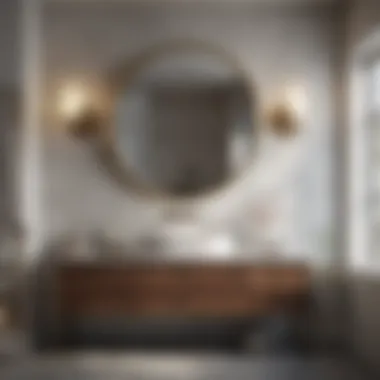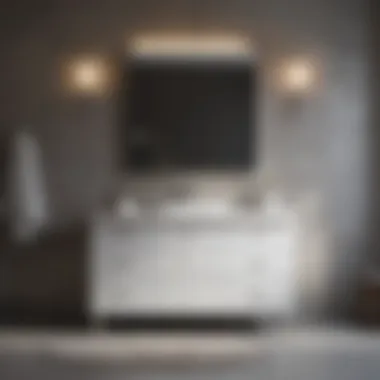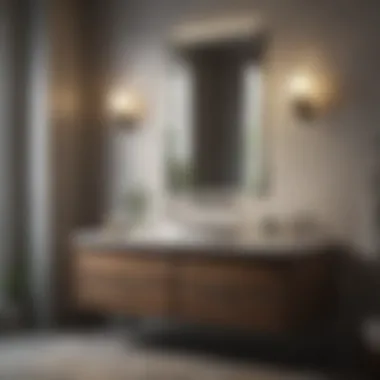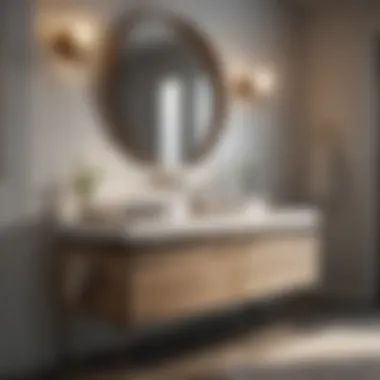Understanding Bathroom Vanity Sizes: A Comprehensive Guide


Intro
Bathroom vanities play a crucial role in both the functionality and aesthetics of any bathroom. Understanding the various sizes and styles of vanities can help homeowners and designers make informed decisions that enhance their spaces. This guide aims to unravel the complexities of bathroom vanity sizes, including key specifications and practical tips for installation and design compatibility. Homeowners should take into consideration their personal style and the dimensions of their bathroom to select a vanity that serves its purpose while complementing the overall design.
Trending Styles
Modern Minimalism
Modern minimalism often features clean lines, simple shapes, and a clutter-free look. The appeal lies in its elegance and flexibility. Many contemporary bathrooms embrace this style, utilizingmaterials like glass and metal, and finishes including matte whites and blacks. With a modern minimalistic vanity, you can opt for floating designs that give an impression of space. Drawers and cabinets with handle-less fronts contribute to the seamless appearance.
Cozy Rustic
Rustic vanities introduce warmth into a bathroom through the use of natural materials and earthy tones. Designed to evoke a homely feel, these vanities often showcase wood grains and distressed finishes. Elements such as a vintage sink and wrought iron knobs can serve as focal points. In a cozy rustic bathroom, the emphasis is on comfort and authenticity, allowing homeowners to create a personal retreat.
Color Palettes
Calming Neutrals
Neutral color palettes create a soothing atmosphere in any bathroom. Shades of beige, cream, and soft grays can blend well, promoting relaxation. Such colors are ideal for those who want a timeless look that adapts effortlessly to changing styles over the years. Incorporating calming neutrals in your vanity can also emphasize the size of the bathroom, making it appear larger and more open.
Bold Accents
For those who desire a striking contrast, bold accents can elevate the design. A deep navy blue or charcoal gray vanity can serve as a dramatic centerpiece in a bright bathroom. When using bold colors, it’s essential to balance them with softer tones or textures throughout the space. This approach creates a harmonious atmosphere while making a bold design statement.
"The size and style of a bathroom vanity can significantly influence the charm of your bathroom space."
The End
Choosing the right bathroom vanity is about balancing style with function. By understanding trending styles and color palettes, you can select a vanity that matches your vision and suits your space. This guide provides valuable insights for homeowners aiming to enhance their bathrooms with vanities that are not only practical but also beautiful.
Importance of Bathroom Vanities
Bathroom vanities hold a vital role in the overall functionality and aesthetics of a bathroom. They are more than just a sink and countertops; they serve as storage solutions, style statements, and significant contributors to the daily routines of the people who use them. Understanding their importance helps in making informed choices when selecting the right vanity for any bathroom space.
Functionality and Storage
The primary purpose of a bathroom vanity is to provide functionality. This includes storage for essential items such as towels, toiletries, and cleaning supplies. Properly designed vanities come with drawers, cabinets, and open shelves, enabling homeowners to organize these items efficiently. An adequate storage solution can significantly reduce clutter, allowing for easier and more effective use of the bathroom space.
Moreover, the functionality expands beyond just storage. For instance, vanities with built-in sinks save space and can streamline morning routines. Adaptable designs can include additional features such as integrated lighting or outlets, which can enhance usability in a practical and convenient way.
Aesthetic Considerations
Vanities contribute significantly to the aesthetic of a bathroom. Their style, color, and material can enhance the overall theme and vibe of the space. Whether contemporary, rustic, or traditional, the choice of a vanity can harmonize with other elements such as tiles, wall colors, and fixtures.
Additionally, the finish and design of the vanity can make a bold statement. A well-chosen vanity can serve as a focal point, drawing attention and admiration. The right color contrasts or complements the bathroom decor, enhancing its appeal and value.
Impact on Bathroom Usage
The choice of vanity can profoundly impact everyday interactions in a bathroom. An appropriately sized and designed vanity ensures that accessibility is maintained. If a vanity is too large, it might make the space feel cramped; if it is too small, it may not provide adequate utility.
For instance, a double sink vanity allows two users to utilize the space simultaneously, promoting efficiency, especially in busy households. It enhances the overall use of the bathroom by facilitating smoother traffic flow and increasing comfort.
In summary, the importance of bathroom vanities cannot be overstated. They combine practicality, visual appeal, and functionality in ways that influence daily life. When selecting a vanity, one should consider these dimensions closely to enhance both the utility and the beauty of the bathroom.
Standard Bathroom Vanity Sizes
Determining the right size for a bathroom vanity is essential. It impacts both function and flow within the space. There are standard dimensions that homeowners can rely on when selecting their vanities. Understanding these standard sizes helps make informed decisions, ensuring that the chosen vanity meets not only aesthetic preferences but also practical needs. A well-chosen vanity can optimize the bathroom layout, enhancing the usability and overall visual appeal.
Single Sink Vanity Sizes
Single sink vanities are popular for smaller bathrooms. Common sizes range from 24 to 60 inches in width. A 30-inch vanity is quite typical, providing enough space for daily bathroom activities. This size also allows for storage beneath without overcrowding the area.
When choosing a single sink vanity, consider the following benefits:


- Space Efficiency: Ideal for compact areas.
- Simplified Design: Easier to match various styles.
- Cost-Effective: Generally more affordable than larger models.
It's important to assess the footprint of the sink and counter space. The depth of these vanities usually ranges from 20 to 22 inches. This dimension accommodates standard sinks while providing necessary surface area.
Double Sink Vanity Sizes
Double sink vanities cater to larger bathrooms or shared spaces. They typically range between 60 and 80 inches wide. A 60-inch double vanity can effectively service two users simultaneously, improving morning routines.
Key considerations include:
- Increased Functionality: More users can access simultaneously.
- Enhanced Style: Can act as a focal point due to size and design.
Common depth for these vanities is similar to single sinks, around 20 to 22 inches. This uniformity allows for better design integration, regardless of the size.
Compact Vanities
Compact vanities address the needs of small bathrooms. Sizes usually range from 18 to 30 inches. Compact options utilize vertical space while maintaining essential function.
Advantages include:
- Space Saving: Perfect for tight areas.
- Design Flexibility: Available in various styles to suit preferences.
- Easy Installation: Lightweight models simplify setup, which can appeal to DIY homeowners.
The depth remains consistent with standard vanities, allowing for an easy integration into existing layouts. Compact vanities often feature built-in storage solutions to maximize utility.
The right bathroom vanity size is not just about looks; it is about function and balance in a confined space.
Chart of Common Bathroom Vanity Sizes
Bathroom vanities come in various sizes, which is reason why understanding their measurements is essential for any renovation or design project. The chart of common bathroom vanity sizes serves as a vital resource for both homeowners and designers. This section will clarify why knowing these sizes is important and how they can guide decision-making.
To begin with, having an accurate reference for vanity dimensions can prevent costly mistakes. If a vanity is too large, it might restrict movement in the bathroom, and if it is too small, it may not meet storage needs. This can be particularly troubling in smaller bathrooms where every inch counts. Additionally, knowing the right dimensions can help in choosing complementary fixtures and accessories, ensuring a cohesive design.
Key benefits of understanding common vanity sizes include:
- Improved Functionality: Adequately sized vanities create better usability, avoiding cramped spaces or wasted areas.
- Enhanced Aesthetic Appeal: The right size contributes to the overall balance and visual harmony of the bathroom.
- Informed Budgeting: Awareness of size can help in evaluating costs, as larger vanities usually demand higher prices, whether custom or pre-fabricated.
Furthermore, the specific elements of width, height, and depth will be discussed next, providing a deeper understanding of how each measurement influences the overall functionality and design of a bathroom vanity.
"Proper sizing can transform a cramped bathroom into a functional workspace, making it comfortable for daily use."
Width Measurements
Width is a primary consideration when selecting a bathroom vanity. Standard vanity widths typically range from 24 to 72 inches, depending on the type of sink configuration. Single sink vanities usually measure between 24 and 48 inches, while double sink options span from 60 to 72 inches. Compact sizes exist for tighter spaces, often at 24 to 30 inches.
When assessing width, it's crucial to evaluate:
- Bathroom Layout: The overall layout dictates how wide your vanity can be.
- Complementary Fixtures: Sink placements, cabinets, and other furnishings must align with width to avoid overlap and maintain access.
- User Needs: Consider the number of users who will need access to the vanity, as more users may necessitate a wider design.
Height Variations
Height is another important factor. Most bathroom vanities are standardized at 30 to 36 inches tall. The trend has gradually shifted toward taller vanities, as they offer ergonomic benefits, reducing strain during use.
In determining the appropriate height, consider:
- User Preferences: Taller individuals may find higher vanities more comfortable.
- Style of Sink: Some sinks require specific heights for proper installation.
- Visual Balance: The height should align with other bathroom elements such as mirrors and shelving for an intentional design.
Depth Considerations
The depth of a vanity typically varies from 18 to 24 inches. This dimension influences storage capacity and overall usability. Shallow designs work well for narrow spaces but may compromise storage.
Points to evaluate regarding depth include:
- Storage Requirements: Shallower vanities may limit items stored.
- Bathroom Size: Deeper cabinets can encroach on floor space, causing discomfort in smaller layouts.
- Sink Type: The choice of vessel or undermount sinks can also affect depth considerations.


By navigating these dimensions carefully, homeowners can make informed choices that elevate both functionality and style in their bathrooms.
Choosing the Right Bathroom Vanity Size
Selecting the correct bathroom vanity size is crucial for various reasons. A thoughtfully chosen vanity enhances functionality, ensures comfort, and elevates the overall design of the bathroom. Many homeowners might underestimate the importance of vanity size and its effect on spatial dynamics. A poorly sized vanity can lead to inconveniences, such as limited storage or difficult usage. Additionally, it may clash with existing décor, disrupting the aesthetic flow of the entire space. It is important to approach this decision with a thorough understanding of available options and personal needs.
Assessing Space Availability
Before making a decision, check the space available in your bathroom. Measure the area where the vanity will be installed. This involves recording the width, depth, and height. Ensure that there is sufficient clearance for doors, drawers, and movement. Consider not only the vanity itself but also the space required for other existing fixtures, such as sinks and toilets.
It’s smart to visualize the vanity in place. Creating a simple floor plan can help. Use graph paper or digital design tools to sketch a layout. This process allows you to experiment with different sizes and styles without the constraints of physical renovation.
User Needs and Preferences
Understanding your needs plays a vital role in vanity selection. Consider how the bathroom is primarily used. Do you need additional storage space for toiletries and other items? Is the vanity functioning solely as a basic utility fixture, or does it also play a role in your home’s overall style?
Discussions with household members can provide insights into common preferences. Each person may have varying requirements. For example, a larger family might benefit from a double-sink vanity to streamline morning routines, whereas an individual might prefer a compact model for a minimalist approach.
Style and Design Synchronization
The style of your chosen vanity should harmonize with the overall design of your bathroom. Select a vanity type that complements your existing décor. Traditional, modern, or transitional styles can create different atmospheres. A cohesive design approach is appealing and ensures that the entire space feels well thought out.
Consider materials and finishes. A wooden vanity, for instance, can lend warmth, while a sleek, glossy finish may add a contemporary edge. Furthermore, examine the color scheme. A misaligned color palette can disrupt visual harmony. Understanding each of these components will facilitate a more seamless integration into your bathroom space.
"The right bathroom vanity can dramatically affect both functionality and style in your home."
Being deliberate in choosing the appropriate size will ultimately result in an efficient and aesthetically pleasing bathroom. Investing time upfront will pay dividends each day you utilize the space.
Custom vs. Pre-Fabricated Vanities
Understanding the differences between custom and pre-fabricated vanities is vital for homeowners looking to enhance their bathrooms. Each option carries its distinct advantages and considerations that impact selection, functionality, and cost. The choice should align with your specific needs, taste, and the characteristics of the space.
Understanding Custom Vanities
Custom vanities offer a tailored approach to bathroom design. They allow for specific measurements, materials, and styling choices that conventional vanities cannot provide. Homeowners can collaborate with designers to create a unique piece that fits perfectly into their space. This process involves selecting wood types, finishes, and hardware that match personal style and interior design.
One critical aspect is the ability to customize functionality. For instance, drawers and shelves can be positioned in a way that maximizes storage for individual needs. The height, width, and depth can also cater to the user’s preferences, ensuring a comfortable experience. However, the custom route typically requires a longer lead time.
Benefits of Pre-Fabricated Options
Pre-fabricated vanities present several practical advantages. They are often readily available, reducing the time needed for installation and allowing homeowners to enjoy their updated spaces sooner. Many are designed with standard dimensions, making them easy to replace or upgrade.
These vanities come in various styles, finishes, and configurations, making it feasible for homeowners to find one that suits their needs without extensive customization.
- Cost-Effectiveness: They typically carry a lower price point compared to custom options.
- Ease of Installation: Many pre-fabricated options come with detailed instructions, allowing for easier installation.
- Variety: Offers a broad range of designs, which lets the homeowner find something suitable quickly.
Cost Implications
When evaluating the financial aspect of vanities, it’s essential to consider both upfront costs and long-term values. Custom vanities generally involve higher initial costs due to bespoke craftsmanship and materials. The buyer often pays for design consultations and skilled labor, making it a more significant investment.
In contrast, pre-fabricated vanities are designed for mass production, meaning they cost less. However, one should also factor in potential long-term implications. A custom vanity, although pricier, may offer increased durability and a longer lifespan due to its quality.
"Investing in a vanity that matches your style and function is not just a purchase; it is an enhancement to your everyday life."
Installation Insights
In the process of selecting a bathroom vanity, one critical aspect that often gets overlooked is the installation. It is important to understand that the quality of installation can have a significant impact on the functionality and longevity of the vanity. Whether you choose a custom or pre-fabricated option, proper installation ensures that your vanity performs optimally, which is vital for daily use in a bathroom setting. It encompasses a range of factors, including preparation, techniques, and the challenges you may encounter.
Preparation Steps
Preparation is essential in any installation project, particularly with a bathroom vanity. Before beginning, you need to gather relevant information and tools. Here are key steps:
- Measure Your Space: Start by measuring the area where you plan to install the vanity. Ensure to account for any plumbing fixtures or obstacles. This will help you choose the right size and style.
- Select the Vanity: Choose a vanity that fits your space and meets your needs. Verify dimensions and configurations before proceeding.
- Shut Off Water Supply: Always turn off water supply lines before dismantling any old fixtures. This minimizes the risk of leaks during installation.
- Remove Existing Vanity: If you are replacing an old vanity, carefully remove it, ensuring not to damage the surrounding walls or flooring.
- Check Floor Level: Ensure the floor is level. If not, you may need to make adjustments before installing the new vanity.


Common Installation Techniques
After preparation, choosing the correct techniques for installation is crucial. Common methods include the following:
- Wall-Mounted Installation: This technique involves securing the vanity directly to the wall. It is ideal for smaller spaces and offers easy floor cleaning. Ensure wall studs can support the weight.
- Freestanding Installation: Many vanities come pre-assembled and simply need to be placed in the designated spot. This method allows more flexibility with design placements and usually requires less labor.
- Plumbing Hook-up: Attaching the plumbing connections is an essential step. Ensure that the sink is securely fastened and that all connections are leak-free.
Potential Challenges
Even with careful planning and execution, challenges can arise during installation. Being aware of them can help you navigate smoothly:
- Unexpected Plumbing Issues: Older homes may have outdated plumbing that does not easily match with new fixtures. You may need additional fittings or an expert plumber to assist you.
- Wall Stability: If using a wall-mounted vanity, check for stable wall construction to support its weight. This includes ensuring existing drywall or paneling is in good condition.
- Floor Unevenness: An uneven floor could affect the vanity’s positioning. You might want to use shims to level it out.
- Space Constraints: Sometimes, the space may not be as accommodating as initially planned. Always double-check measurements and adjust your installation method if necessary.
Proper installation not only enhances the use of your bathroom vanity but also extends its lifespan. Investing attention into this process saves time and money in the long run.
Maintaining Your Bathroom Vanity
Maintaining your bathroom vanity is essential for ensuring its longevity and appearance. A well-maintained vanity not only enhances the overall aesthetics of your bathroom but also promotes hygiene. Regular upkeep prevents the accumulation of dirt and grime, which can lead to more significant issues over time. Proper care helps sustain the quality of materials used, prolonging the life of your investment.
Cleaning Procedures
Regular cleaning of your bathroom vanity is important. The surface will accumulate dust, soap, and water stains. To clean effectively, follow these steps:
- Use a Mild Cleaner: Avoid harsh chemicals which can damage the finish. Use a mixture of warm water and a few drops of dish soap for routine cleaning.
- Soft Cloth: A microfiber cloth works best. Dip it in the cleaning solution, wring it out, and gently wipe down all surfaces.
- Rinse and Dry: After cleaning, rinse the cloth with clean water and wipe down the surfaces again. This removes any soap residue. Finally, dry everything with a clean towel to prevent water spots.
Consistency in cleaning helps maintain the finish and prevents the build-up of harmful bacteria. Schedule cleaning once a week or bi-weekly depending on usage.
Avoiding Damage
Protecting your bathroom vanity from damage is crucial. Here are some practical tips:
- Avoid Excess Water: Keep items like toothbrush holders and containers dry. Water can warp wood or damage the finish.
- Use Coasters: For cosmetics or bottles, using coasters can prevent rings from forming on the surface.
- Mind Sharp Objects: Avoid placing sharp items directly on the vanity, as they can scratch the surface. Consider using trays for organization.
- Temperature Control: Extreme temperatures can cause materials to contract or expand, leading to damage. Avoid placing heat-producing devices directly on the vanity.
By implementing these precautions, you can preserve the condition of your bathroom vanity for years to come.
Signs of Wear to Watch For
Monitoring your bathroom vanity for signs of wear is crucial for early intervention. Pay attention to the following:
- Cracks in the Surface: Check for any splits or cracks, especially in wooden vanities, as this may indicate dryness or water damage.
- Peeling or Flaking Paint: If you notice any discoloration or paint peeling, this can be a sign of moisture infiltration.
- Warping: Feel the surface for any unevenness. Warping indicates severe damage, often caused by excess moisture.
- Stains: Persistent stains that do not respond to cleaning may signal deeper damage to the finish.
Taking immediate action at the first sign of wear can prevent larger repair costs and maintain the beauty of your bathroom.
Regular maintenance and care can extend the life of your vanity, enhancing your bathroom's value both in functionality and aesthetics.
Maintaining your bathroom vanity is not just about cleaning. It requires a comprehensive understanding of how to care for the materials, recognizing potential hazards, and being vigilant about signs of wear.
Closure: Finding the Right Balance
Choosing the right bathroom vanity is a task that requires careful consideration of both functional needs and stylistic preferences. This article has outlined various aspects of bathroom vanities and their sizes, providing a pathway to navigate through the options available. It is vital to understand that the decision becomes more than just about size; it integrates how well the vanity will work within your bathroom's layout and aesthetic.
With numerous styles and configurations, finding a balance between function and design can greatly enhance the overall experience of using a bathroom. Homeowners must not only think about the amount of storage space they need but also how the chosen vanity complements the existing decor. Both practicality and visual appeal play a significant role in ensuring the bathroom remains a comfortable and inviting space.
Ultimately, a well-chosen vanity should cater to everyday needs while also reflecting personal style. As you weigh options, consider both immediate needs and future plans for your space. It might also be beneficial to examine how changes in function can impact long-term usage.
"Balance is not better time management, but better boundary management. Balance means making choices and enjoying those choices."
Integrating Function and Style
Integrating function and style is crucial when selecting a bathroom vanity. The sheer variety of design options means that homeowners can find choices that align with personal taste while still being practical. Simple features, such as drawer organization and accessible shelving, play a significant role in day-to-day usability.
- Assess your needs: Consider how many people use the bathroom regularly and how much storage is required.
- Evaluate space: Measure available space meticulously; this helps in selecting the ideal size without overcrowding the room.
- Harmonize colors: Select a color scheme and material that blends seamlessly with other elements in the bathroom.
In this pursuit, it is essential to remain open to various styles. Modern, traditional, or eclectic designs can all merge function with aesthetics. The goal should be a vanity that not only fulfills practical needs but also enhances the room's design.
Long-term Considerations
When investing in a bathroom vanity, long-term considerations should not be overlooked. A vanity isn't just a temporary fixture; it is often a lasting component of your bathroom layout. Several factors come into play when thinking about longevity.
- Quality of Materials: Opt for durable materials that withstand moisture and daily usage.
- Maintenance Needs: Understand how different styles and finishes will require varying levels of upkeep. Some materials can be easier to clean than others, influencing long-term satisfaction.
- Future-Proofing: The bathroom's needs may change over time. Consider how adaptable the vanity is to accommodate additional storage or modifications in layout as family dynamics evolve.















